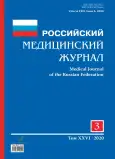Cochleovestibular disorders: clinical and pathogenetic aspects
- Authors: Tardov M.V.1, Damulin I.V.2,3
-
Affiliations:
- L.I. Sverzhevsky Research Institute of Clinical Otorhinolaryngology
- Medical Institute of People's Friendship University of Russia
- I.M. Sechenov First Moscow State Medical University (Sechenov University)
- Issue: Vol 26, No 3 (2020)
- Pages: 188-194
- Section: Reviews
- URL: https://journals.rcsi.science/0869-2106/article/view/48519
- DOI: https://doi.org/10.17816/0869-2106-2020-26-3-188-194
- ID: 48519
Cite item
Abstract
The article discusses the pathogenetic and clinical aspects of vestibular and cochlear disorders such as dizziness, tympanophony, and vestibular ataxia. It is emphasized that the vestibular system provides not only the relationship between motor and sensory processes but its functions are also much more significant. The uniqueness of the vestibular system consists of its multisensory cortical projections. The analysis of vestibular information is provided by a network of connections, which its epicenter is located in the depths of the Sylvian fissure and the surrounding parietal-temporal regions, and the retroinsular region. It has been suggested that the vestibular cortex can be considered a network of connections between all cortical areas receiving impulses from the vestibular system, including regions where vestibular information affects the analysis of other sensory (i.e., somatosensory and visual) and motor activity. The pathogenetic mechanisms of dizziness, tympanophony, and ataxia are discussed. The conclusion is made about the significance of connectome disorders in this patient category.
Keywords
Full Text
##article.viewOnOriginalSite##About the authors
Mikhail V. Tardov
L.I. Sverzhevsky Research Institute of Clinical Otorhinolaryngology
Email: mvtardov@rambler.ru
ORCID iD: 0000-0002-6673-5961
MD, PhD, DSc
Russian Federation, MoscowIgor’ V. Damulin
Medical Institute of People's Friendship University of Russia; I.M. Sechenov First Moscow State Medical University (Sechenov University)
Author for correspondence.
Email: damulin@mmascience.ru
ORCID iD: 0000-0003-4826-5537
MD, PhD, DSc, Professor
Russian Federation, MoscowReferences
- Neuhauser H.K. The epidemiology of dizziness and vertigo. In: Furman J.M., Lempert T., eds. Handbook of Clinical Neurology. Neuro-Otology. Amsterdam: Elsevier; 2016:67-82. doi: 10.1016/B978-0-444-63437-5.00005-4.
- Goldberg G.M. Multisensory vestibular inputs: the vestibular system. In: Pfaff D.W., ed. Neuroscience in the 21st Century: From Basic to Clinical. New York: Springer; 2013: 883-929.
- Cullen K.E. Physiology of central pathways. In: Furman J.M., Lempert T. eds. Handbook of Clinical Neurology. Neuro-Otology. Amsterdam: Elsevier; 2016:17-40. doi: 10.1016/b978-0-444-63437-5.00002-9.
- Wiest G., Zimprich F., Prayer D., Czech T., Serles W., Baumgartner C. Vestibular processing in human paramedian precuneus as shown by electrical cortical stimulation. Neurology. 2004;62(3):473-5. doi: 10.1212/01.wnl.0000106948.17561.55
- Lee H. Isolated vascular vertigo. J Stroke. 2014;16(3):124-30. doi: 10.5853/jos.2014.16.3.124
- Ferre E.R., Bottini G., Haggard P. Vestibular inputs modulate somatosensory cortical processing. Brain Struct Funct. 2012;217(4): 859-64. doi: 10.1007/s00429-012-0404-7
- Kirsch V., Keeser D., Hergenroeder T., Erat O., Ertl-Wagner B., Brandt T., Dieterich M. Structural and functional connectivity mapping of the vestibular circuitry from human brainstem to cortex. Brain Struct Funct. 2015;221(3):1291-308. doi: 10.1007/s00429-014-0971-x.
- Lopez C., Blanke O., Mast F.W. The human vestibular cortex revealed by coordinate-based activation likelihood estimation meta-analysis. Neuroscience. 2012;212:159-79. doi: 10.1016/j.neuroscience.2012.03.028.
- zu Eulenburg P., Caspers S., Roski C., Eickhoff S.B. Meta-analytical definition and functional connectivity of the human vestibular cortex. Neuroimage. 2012;60(1):162-9. doi: 10.1016/j.neuroimage.2011.12.032.
- Dieterich M., Brandt T. Functional brain imaging of the vestibular system: fMRI and PET. In: Eggers S.D., Zee D.S., eds. Vertigo and Imbalance: Clinical Neurophysiology of the Vestibular System. Handbook of Clinical Neurophysiology. Vol. 9. Amsterdam: Elsevier; 2010:303-12.
- Kirsch V., Kierig E., Keeser D., Temmuz K., Ertl-Wagner B., Brandt T., Dieterich M. Contra- and ipsilateral pathway-dependent cortical connectivity mapping of the vestibular network. Clin Neurophysiol. 2016;127(9):e224. doi: 10.1016/j.clinph.2016.05.045.
- Dieterich M., Bense S., Lutz S., Drzezga A., Stephan T., Bartenstein P., Brandt T. Dominance for vestibular cortical function in the non-dominant hemisphere. Cereb Cortex. 2003;13(9):994-1007. doi: 10.1093/cercor/13.9.994.
- Klingner C.M., Volk G.F., Flatz C., Brodoehl S., Dieterich M., Witte O.W., Guntinas-Lichius O. Components of vestibular cortical function. Behav Brain Res. 2013;236:194-9. doi: 10.1016/j.bbr.2012.08.049.
- Helmchen C., Ye Z., Sprenger A., Munte T.F. Changes in resting-state fMRI in vestibular neuritis. Brain Struct Funct. 2013;219(6): 1889-900. doi: 10.1007/s00429-013-0608-5.
- Lieto M., Roca A., Santorelli F.M., Fico T., De Michele G., Bellofatto M., Saccà F., De Michele G., Filla A. Degenerative and acquired sporadic adult onset ataxia. Neurol Sci. 2019;40(7):1335-42. doi: 10.1007/s10072-019-03856-w.
- Neely D.E., Sprunger D.T. Nystagmus. Curr Opin Opthalmol. 1999; 10(5):320-6. doi: 10.1097/00055735-199910000-00007.
- Moller A.R., De Ridder B.L., Kleinjung T. Textbook of tinnitus. New York: Springer; 2011. doi: 10.1007/978-1-60761-145-5.
- Han L., Zhaohui L., Fei Y., Ting L., Pengfei Z., Wang D. et al. Abnormal baseline brain activity in patients with pulsatile tinnitus: a resting-state fMRI study. Neural Plast. 2014;2014:549162. doi: 10.1155/2014/549162.
- Maudoux A., Lefebvre P., Cabay J.E., Demertzi A., Vanhaudenhuyse A., Laureys S., Soddu A. Auditory resting-state network connectivity in tinnitus: a functional MRI study. PLoS One. 2012;7(5):e36222. doi: 10.1371/journal.pone.0036222.
- Minami S.B., Oishi N., Watabe T., Uno K., Kaga K., Ogawa K. Auditory resting-state functional connectivity in tinnitus and modulation with transcranial direct current stimulation. Acta Otolaryngol. 2015; 135(12):1286-92. doi: 10.3109/00016489.2015.1068952.
- Eggermont J.J. Neural substrates of tinnitus in animal and human cortex. Cortical corelates of tinnitus. HNO. 2015;63(4):298-301. doi: 10.1007/s00106-014-2980-8.
- Norena A.J., Farley B.J. Tinnitus-related neural activity: theories of generation, propagation, and centralization. Hear Res. 2013;295: 161-71. doi: 10.1016/j.heares.2012.09.010.
- Song J.J., Vanneste S., Schlee W., Van de Heyning P., De Ridder D. Onset-related differences in neural substrates of tinnitus-related distress: the anterior cingulate cortex in late-onset tinnitus, and the frontal cortex in early-onset tinnitus. Brain Struct Funct. 2013;220(1): 571-84. doi: 10.1007/s00429-013-0648-x.
- Labar D., Labar A.S., Edwards D. Long-term distributed repetitive transcranial magnetic stimulation for tinnitus: a feasibility study. Neuromodulation. 2016;19(3):249-53. doi: 10.1111/ner.12390.
Supplementary files






